Unit III: Social Justice in Digital Humanities Practice
3.7 Shanghai Cultural Collections: The interplay between genre, stories and memory
This case study is written by Yaming Fu. This case study is designed by Emma Prebreza and Claudio Lo Sciuto.
Introduction
The Shanghai Cultural Collections Database (上海文化总库) is a digital humanities platform designed and maintained by Shanghai Library. It integrates a wide range of resources and knowledge databases related to Shanghai city in modern times (1825-1949, from the opening of the Treaty Port at the end of the Qing Dynasty to the founding of the People's Republic of China and beyond), presenting resources that reflect the events, people, life, buildings, and social status as shown in the press and other publications, literature, film, drama, music, art and other categories.
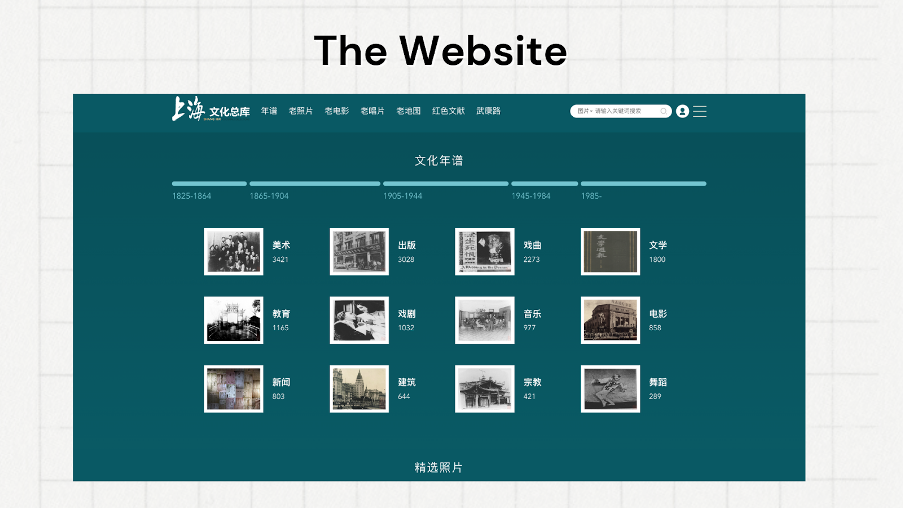 |
| Figure 1: The homepage of Shanghai Cultural Collections |
These diverse types of resources are linked together on the platform and include books and other collections, old photos, motion pictures, musical records, maps, and audio-visual resources which record Shanghai's historical image and sound; they reflect Shanghai's cultural characteristics and tell the stories and share the knowledge behind the culture. The platform aims to connect the library collections with Shanghai historical and cultural chronology to build a digital Shanghai memory.
Rationale for the project
Since 2014, Shanghai Library has constructed digital humanities projects using Semantic Web technologies. The descriptive information of the collections themselves, the related data and the relationships between them are encoded in a standard format via knowledge organization methods and linked data. Knowledge organization methods and linked open data are applied to extract the relevant elements and related details about people, location, time, events, and activities from the appropriate library collection resources with the specific requirements from the users. The knowledge organization method, which combines Bibliographic Control and Authority Control of the library with the technical Ontology, provides the implementation scheme.
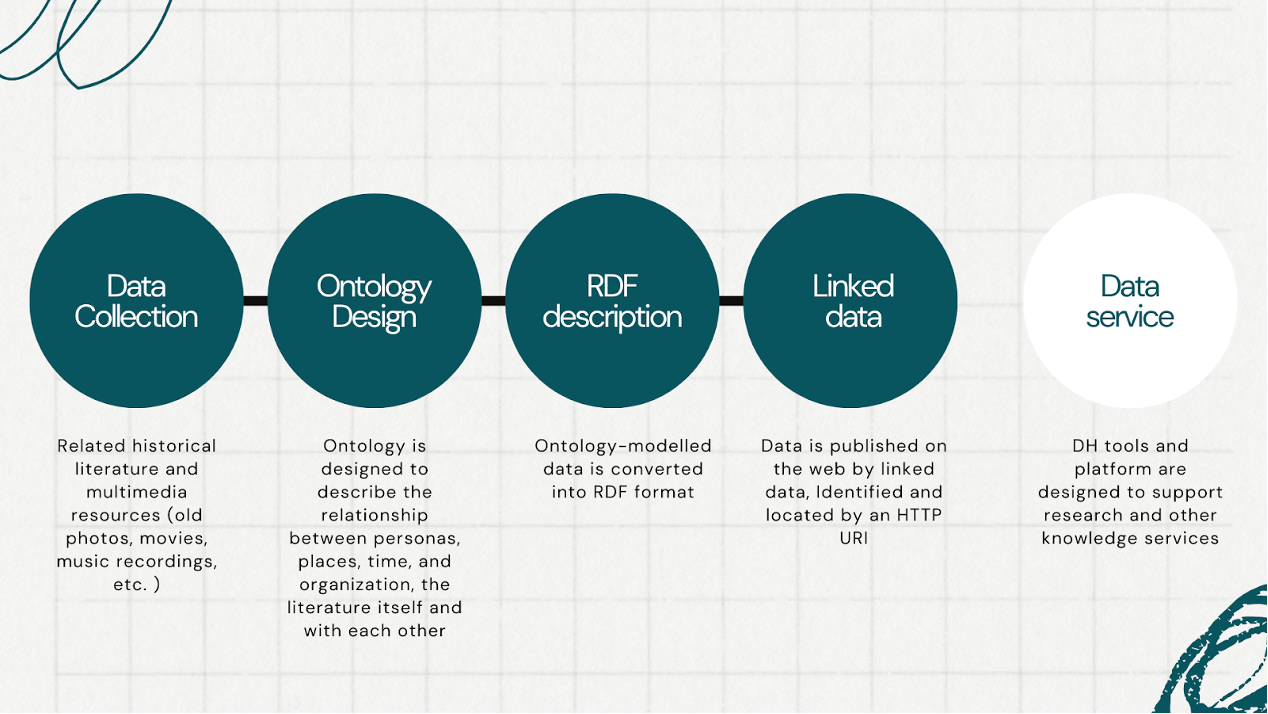 |
| Figure 2: The rationale behind DH projects constructed at Shanghai Library |
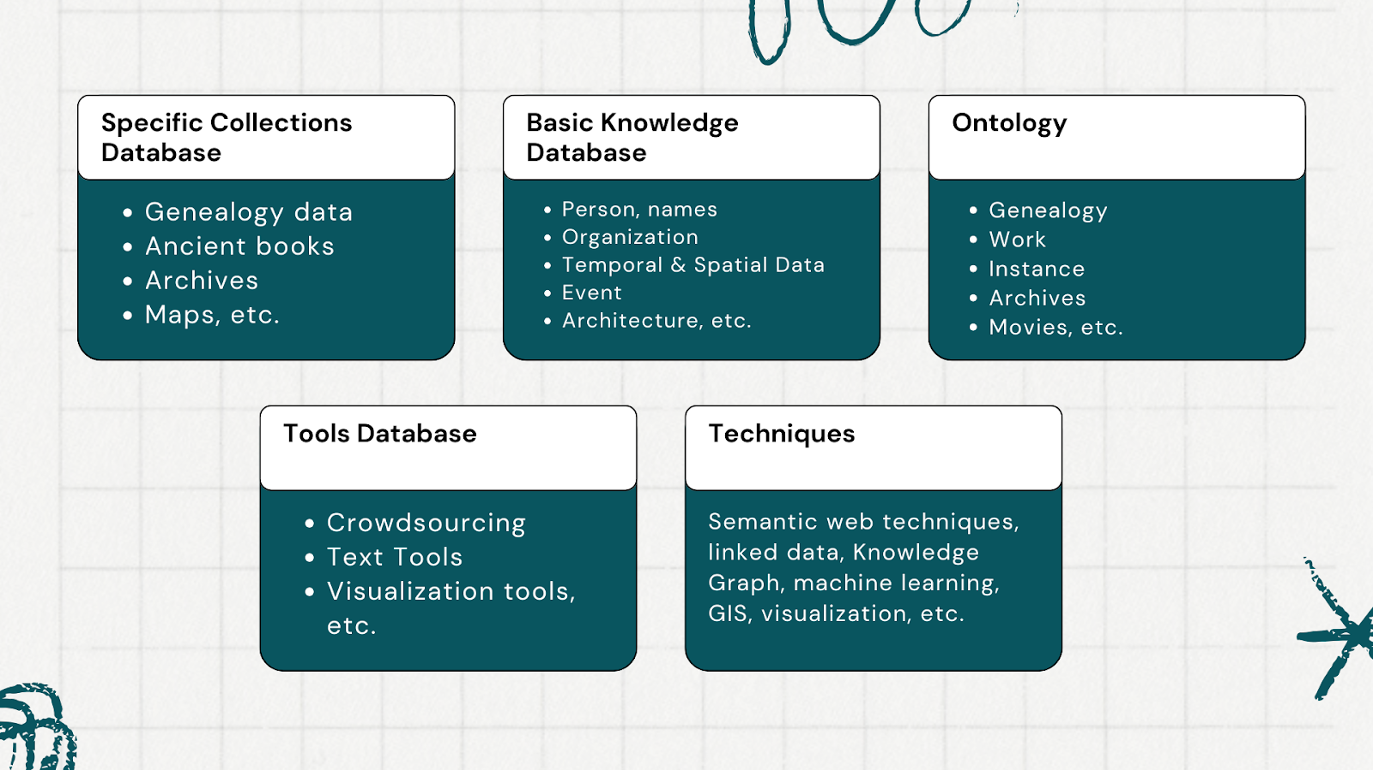 |
| Figure 3: The rationale behind Shanghai Cultural Collections platform |
Traditional historical narratives often focus on dominant perspectives, sidelining or erasing the experiences of marginalized communities. Incorporating diverse resources like archival materials, personal accounts and old photos into a digital platform, can help bring forth the stories of those who have been historically marginalized, promoting a more inclusive and just representation of the city's history. Through making these various types of historical resources accessible via a digital platform, this project serves as an educational tool for raising awareness about the complexities of a city’s history and their lasting impact on social justice issues.
More importantly, as this is the public library in Shanghai, the project and its future development involves collaboration with local communities, giving them a platform to share their personal stories and contribute to the representation of their histories. In our project, ‘[…] digital methods help us to access and share marginalized or silenced voices and to incorporate them into our work in ways not possible in print or the space of an exhibition gallery.’ (Brennan, 2019). The official records held in the archives and libraries have to an extent been mediated and represent the official record, regardless of the sources, with all the inherent and unescapable biases. In Shanghai these have been particularly influenced by the long-term colonial occupation and the shorter but to an extent more divisive ravages of the Japanese occupation. The prevailing historical record has been unavoidably shaped by these events and factors external to Shanghai and China. As Jennifer Guilliano argues, ‘the embrace of capitalism, and the consequences of colonialism have long affected and been central in the discipline of history’ (Guilliano, 2022. p.5.). This project fills the gaps in the historical and cultural record so that we can ‘ensure that the stories and voices which have been underrepresented in both print and digital knowledge production […] can be heard (Risam, 2018. p.129). This participation will empower these communities and provide them with a means for their voices to be heard and acknowledged.
In this project, we also follow cultural memory theory from Assmann and Czaplicka where cultural memory connects together the three aspects of ‘memory (the contemporized past), culture, and the group (society)’, emphasizing the different ways in which communities form their cultural understanding over the course of their history (Assmann and Czaplicka, 1995. p.129).
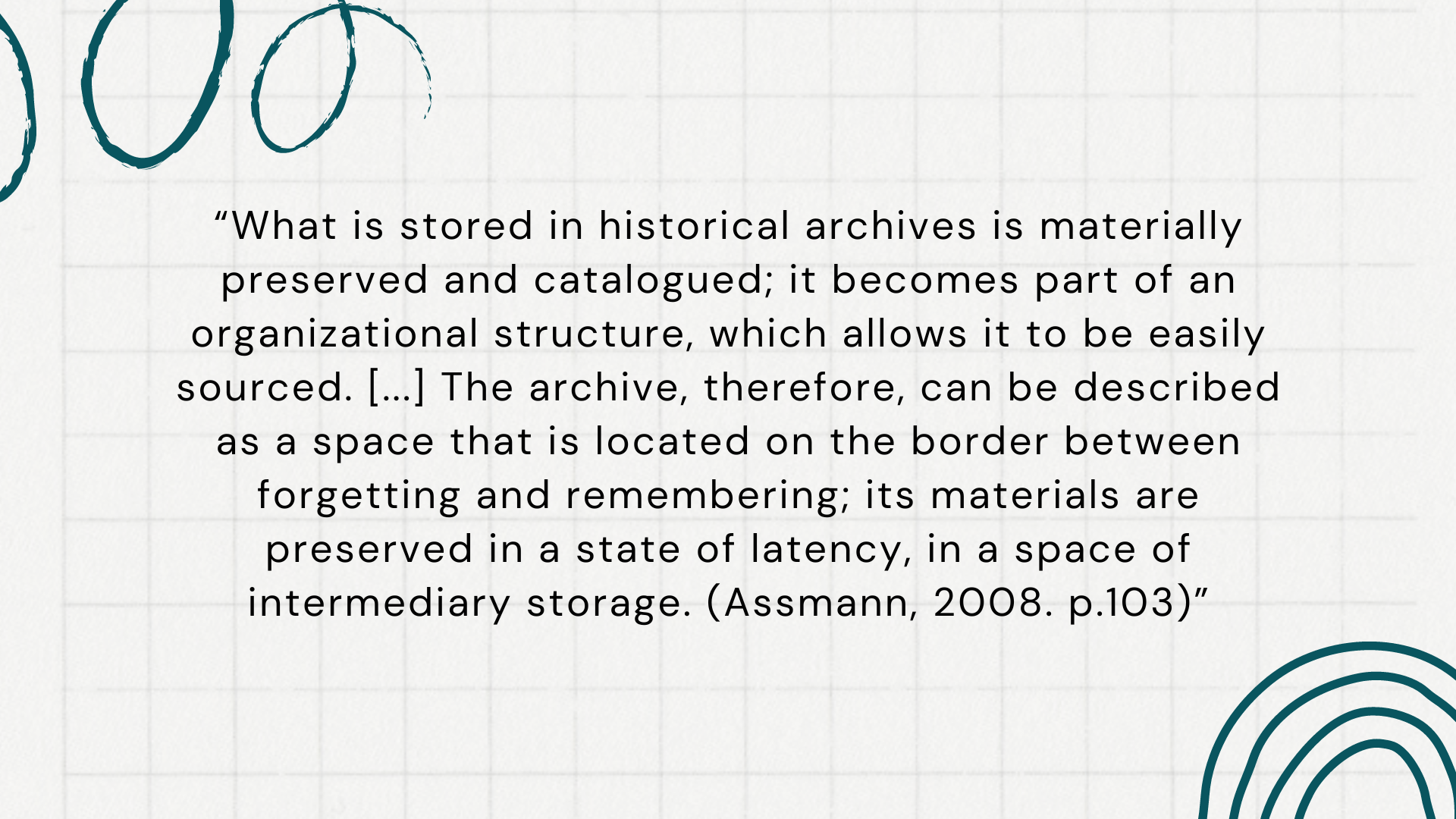 |
| Figure 4: Quote from Assmann, 2008 |
To interpret the inert knowledge hidden in the memory archives, it can be inspected and reclaimed by situating it in a new memory context (Assmann, 2008). Moreover, the feelings experienced in places that carry the passage of time and historical events are more vivid than those experienced by reading. The physicality of place combined with personal history and experience can trigger powerful emotions. Moving through a space ‘at a particular time, in a particular way […] might deepen our understanding of human interaction with [that] place more broadly. It means communicating these things meaningfully as stories or arguments’ (Dunn, 2019. p.156)
Why digital humanities
In this project, a digital humanities paradigm and relevant methods are adopted to integrate, link, curate and help to explore various types of historical resources preserved in our library and beyond. Digital methods allow for the preservation of memories and the continued accessibility of the information held in our diverse historical resources. By digitizing archives, old photos, maps, and other materials, these resources become widely available, overcoming physical limitations and ensuring that the information they hold is not lost to time or deterioration. Moreover, the digital platform makes it possible for researchers from various locations and backgrounds to access the information without the need to physically visit the library. This reduces barriers related to geography, financial resources, and physical abilities, promoting equal opportunities for researchers regardless of their location or circumstances.
Functions:
1) This platform serves as a one-stop disclosure of the diverse cultural resources in Shanghai, and provides the exploration on the correlation and interoperability of multiple types of resources through standardized entities such as personal names, organization, and place names.
2) According to the characteristics of the resources, they reveal various information visually in the form of timelines, maps, films, etc.
3) Linked data techniques enable the connection of various types of information. This interconnectedness allows for a more holistic view of the history, connecting different narratives, events, and perspectives. It helps in revealing patterns, relationships, and dependencies that might not be immediately apparent in the traditional, isolated historical records.
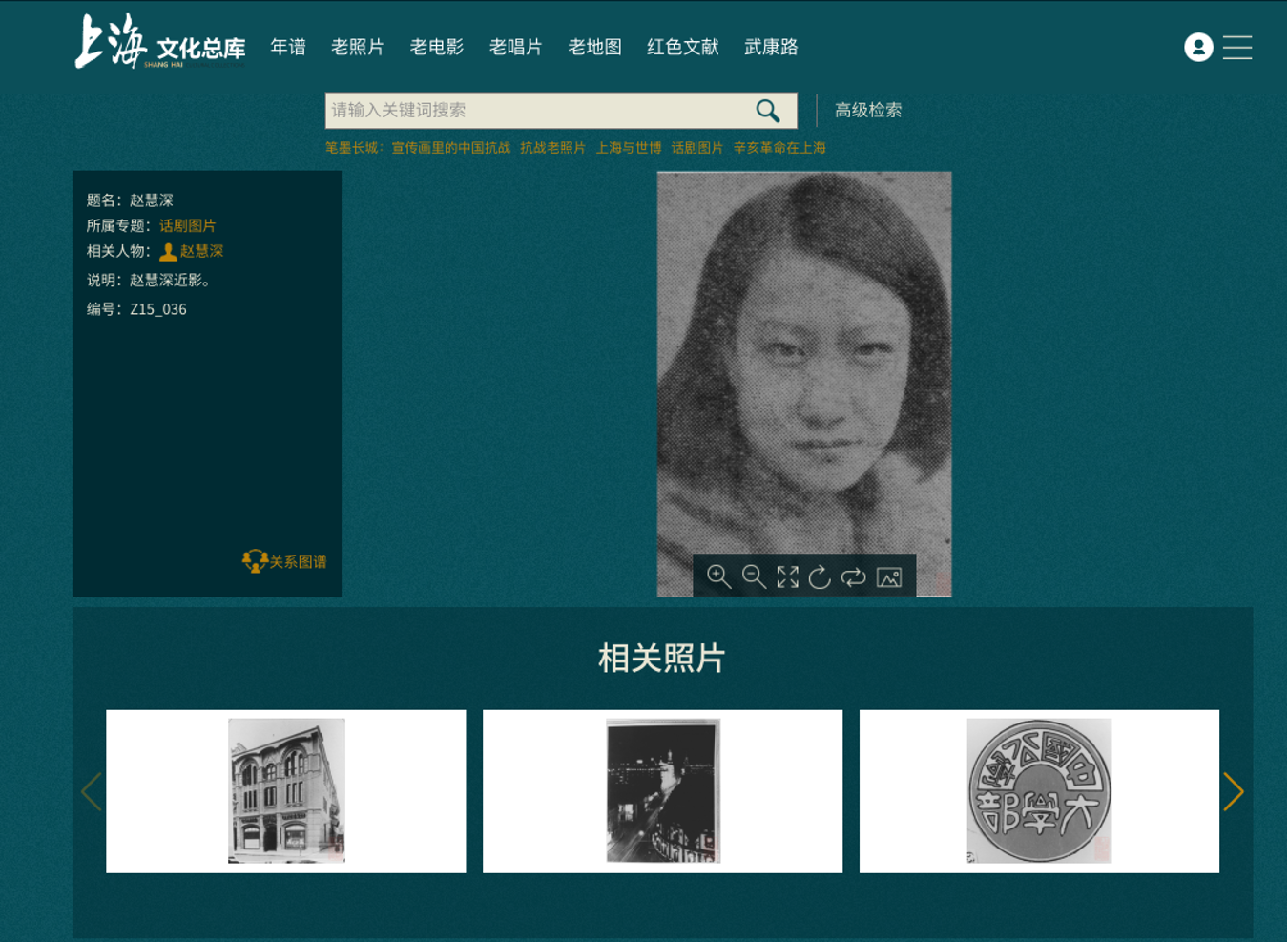 |
| Figure 6: The interface for exploring old photos, as well as photos related to it |
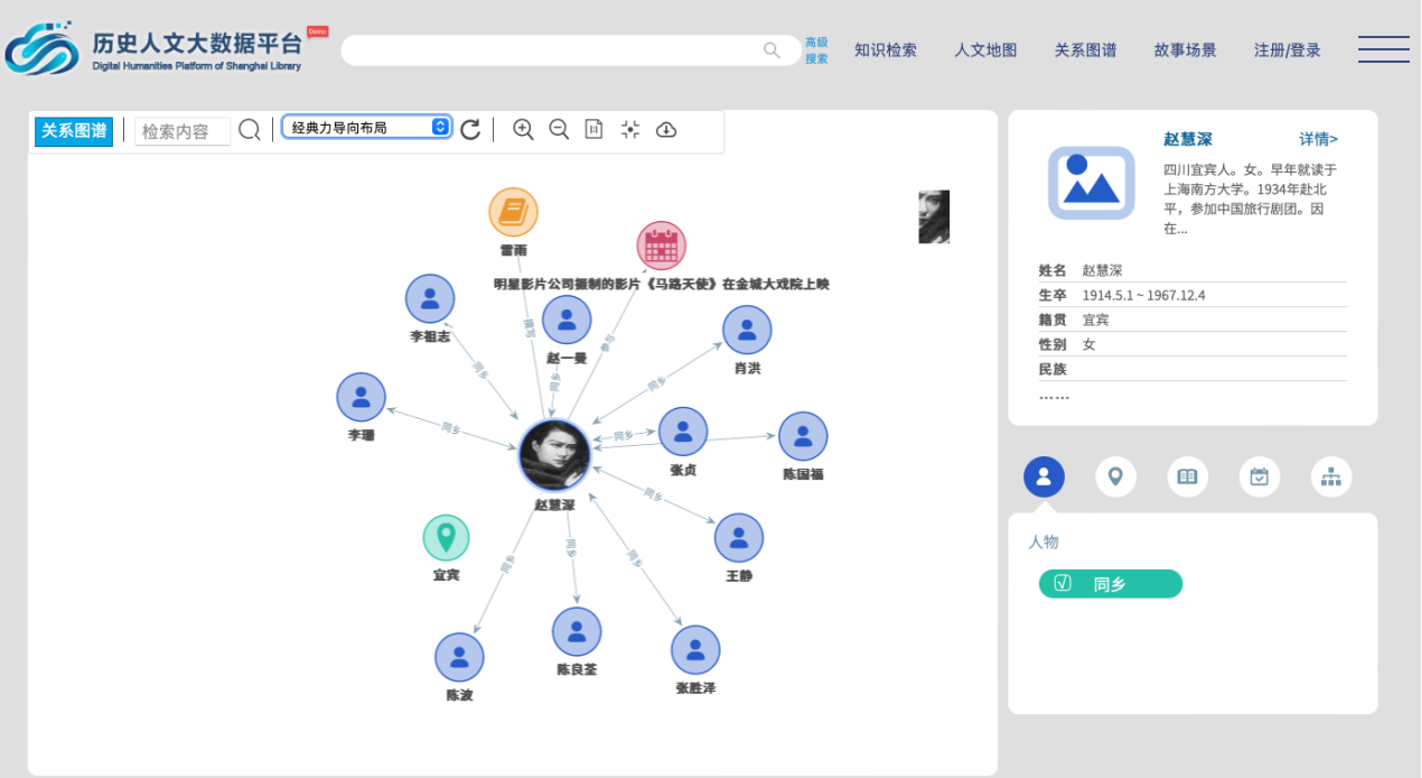 |
| Figure 7: This is a mapping of the relationships of a chosen individual, made possible through linked data |
4) Spatial and temporal visualizations, such as Historical Geographic Information Systems (HGIS), provide intuitive ways to present complex historical data. They allow users to see patterns, changes over time, and spatial relationships, making historical narratives more engaging and understandable for a broader audience.
 |
| Figure 8: You can explore information about the movie theatre in many ways |
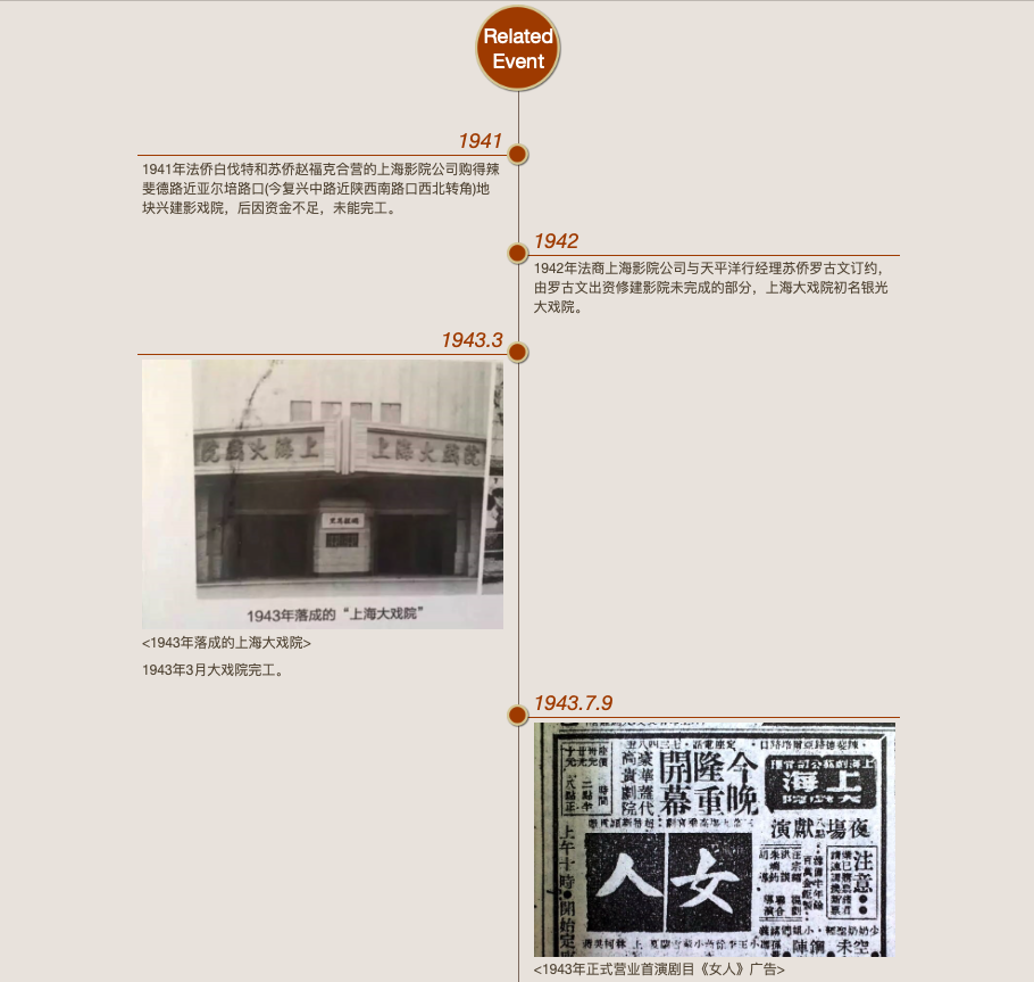 |
| Figure 9: Related events are visualised in a timeline view |
5) Users can engage with the platform, explore different resources, and, where possible and appropriate, even contribute their own materials or stories. This interactivity fosters a sense of participation, empowering communities and encouraging dialogue around historical narratives and social justice issues.
By leveraging these digital humanities methods, the Shanghai Cultural Collections project creates a comprehensive and inclusive digital platform that not only archives historical information but also actively contributes to raising awareness, promoting dialogue, and fostering a more just understanding of the city's history and its implications for social justice. The project provides a platform for the voices which are usually excluded from the official record – the marginalized and otherwise less represented citizens.
Author Bio Notes*:
Dr. Yaming (Cindy) Fu is a lecturer on Archival Science in the School of Cultural Heritage and Information Management, Shanghai University. She received her PhD from the University College London, UK, in 2021 in Library and Information Studies. Her research interests include the library user studies, archives and records management, and digital humanities.
Designer Bio Notes*:
Emma Prebreza is currently a 3rd-year student of the BA Digital Society at Maastricht University. She participates in the university’s Honours Programme, through which she is contributing to the #dariahTeach project as an editor. For her bachelor’s thesis titled Capturing Motherhood: Exploring Sharenting among Slovak Millennial Mothers, she explored the contemporary practice of sharing multimedia content about children in the context of normative expectations of motherhood. Next to her studies, she works as a project coordinator at Bratislava Policy Institute, one of Slovakia’s leading democratic think tanks. Starting in the academic year of 24/25, she will start her master’s degree in International Public Policy and Public Management at Erasmus University in Rotterdam and is interested in pursuing a career in the field of digitalisation and public policymaking.
Claudio Lo Sciuto (He/Him) is currently a 3rd-year student of the BA Digital Society at Maastricht University. He participates in the university’s Honours Programme, through which he is contributing to the #dariahTeach project as an editor. Next to his studies, he works as an IT student assistant for the Faculty of Arts and Social Sciences. Additionally, he recently finished an internship at the Brightlands Institute of Smart Society (BISS), a research centre which focus is the development of ethical AI systems. He is tech-savvy and in the academic year of 24/25 will pursue an MSc in Techno-anthropology at Aalborg University.
*Bios and affiliations are accurate at the time of writing.
References
- Assmann, A. (2008). Canon and archive. In Erll, A. and Noơnning, A. (eds), Cultural Memory Studies: An International and Interdisciplinary Handbook. Germany: De Gruyter, pp. 97–107.
- Assmann, J. and Czaplicka, J. (1995). Collective memory and cultural identity. New German Critique, 65: 125–33.
- Brennan, S. (2019). Digital history. The Inclusive Historian’s Handbook. https://inclusivehistorian.com/digital-history (accessed 15 January 2024).
- Dunn, S. (2019). A History of Place in the Digital Age, 1st edn. London: Routledge.
- Fu, Y., Mahony, S., & Liu, W. (2023). Reconstruction of cultural memory through digital storytelling: A case study of Shanghai Memory project. Digital Scholarship in the Humanities, fqad044.
- Guilliano, J. (2022). A Primer for Teaching Digital History: Ten Design Principles. Durham, NC: Duke University Press.
- Risam, R. (2018). New Digital Worlds: Postcolonial Digital Humanities in Theory, Praxis, and Pedagogy. Evanston, IL: Northwestern University Press.

